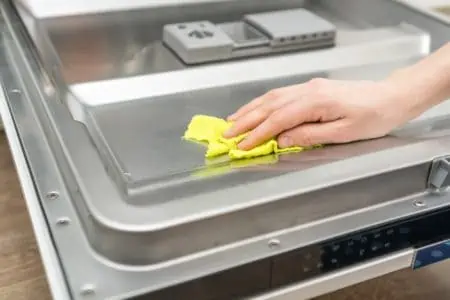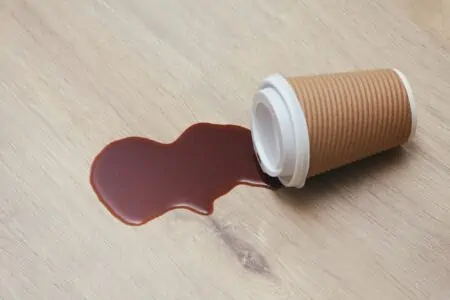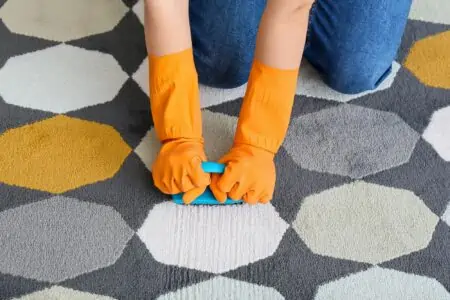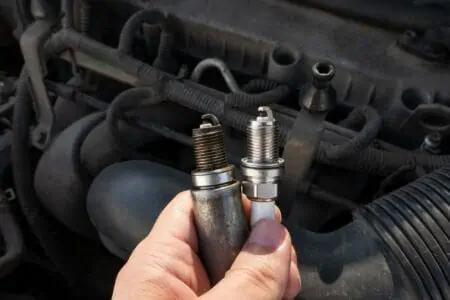Stainless steel might be a durable and reliable choice for appliances or other home pieces. But did you know there are some pretty important do’s and don’ts when cleaning stainless steel?
We’ll walk you through how to clean stainless steel so that it’s sparkling clean and streak-free. Our methods will assure that you don’t damage your appliances but keep them up and running for longer.
Whether you want to clean jewelry, pans, or stoves, or simply want to use an all-natural cleaner, we have the answers for you so keep reading.
Key Takeaways
- Avoid steel wool, abrasive cleaners, bleach, and ammonia-based products when cleaning stainless steel.
- Use gentle cleaners like dish soap, WD-40, Bon Ami, or Bar Keepers Friend for effective cleaning.
- Natural cleaning options include vinegar and olive oil, baking soda and vinegar, or club soda.
- Remove fingerprints with glass cleaner or mineral oil, and clean rust using baking soda or specialized cleaners.
- What Should You Not Use on Stainless Steel?
- What To Use When Cleaning Stainless Steel
- How to Clean Stainless Steel Appliances Naturally
- How to Clean Stainless Steel Jewelry
- How to Clean Stainless Steel Pans
- How to Clean Fingerprints Off Stainless Steel
- How to Clean Rust Off Of Stainless Steel
- FAQs
- Spotless Steel
What Should You Not Use on Stainless Steel?
While it’s generally quite difficult to completely ruin stainless steel, we will start with the warnings. It’s important to keep these in mind for the best care of your steel items.
Here are products and tools you should avoid (as they can scratch and damage steel):
- Steel wool or brushes: These can damage the surface, which can increase the chances of rust and stains.
- Abrasive cleaners: Avoid using any textured or coarse cleaners, such as salt. It can scratch the steel and dull the shiny finish.
- Scouring powders: Scouring powder is a cleaner that includes detergent mixed with an abrasive powder. It can scratch and dull down steel.
- Bleach: This is a big one. Bleach is corrosive and can cause damage. It reduces the quality of the stainless steel, making it duller and more susceptible to stains. This point includes other chlorine-based products too.
- Hard water: If you live in a hard water area, opt for distilled or filtered water. The hard water minerals can stain and streak your stainless steel.
- Ammonia-based products: Cleaners that contain ammonia — such as glass cleaners — can be corrosive to stainless steel. While it might do a good job cleaning, it can ruin the metal if you use it too frequently.
- Oven cleaners: The harsh caustic chemicals in an oven cleaner can damage your stainless steel.
What To Use When Cleaning Stainless Steel
Okay, that list seemed a little long. Is there anything you can use for cleaning stainless steel? Absolutely! Many cleaners will treat your stainless steel gently while also giving it a deep clean. Whether you’re cleaning your oven, your refrigerator door, or Samsung dishwasher, we’ve got you covered.
Dish Soap
Yes, something you probably already have in the house! Dish soap is a fantastic option for cleaning stainless steel, especially if it’s covered in food stains, grease, and grime. If your stovetop is looking particularly grubby, dish soap might be the top choice in that circumstance.
Mix a few drops of dish soap in warm water. Dampen a cloth in the solution, squeeze it out, and wipe down the stainless steel. Afterward, dry it with a separate cloth for a streak-free finish.
Top Tip
You can leave streaks if you use hard tap water, and don’t dry the area immediately. So use filtered water and dry ASAP, preferably with a lint-free cloth.
WD-40
This product is designed to drive out moisture, moisturize surfaces and protect surfaces from rust. So if your stainless steel is looking dull, grubby, and rusty, then this is a good option to try.
Spray WD-40 onto a cloth and buff the stainless steel appliance until it’s clean.
Keep in mind that the main drawback of this is that when you spray the WD-40, the fumes can get into the air. They’re very strong and irritating for some people! So if you want a more natural and subtle cleaner, you may want to try something else.
Bon Ami
Translating to “good friend”, this product might be your favorite companion when cleaning stainless steel appliances. While we said to avoid powdered cleaners, this one is gentle enough to be a safe option.
To use it, sprinkle some into a bowl and add water until you have created a paste. Dip a sponge into the solution, then gently scrub it onto your stainless steel item. Rinse the sponge, wipe the steel again, and then buff it dry with a separate cloth.
This is an all-purpose kitchen cleaner, so it’s best for general dirt and stains on your stainless steel appliance. It works across the kitchen without scratching! Customers find that it works a charm, so if you want to purchase a specialized cleaner, this might be one to try.
Bar Keepers Friend
Bar Keepers Friend is another specialized cleaner designed to work on stainless steel and other materials. In the kitchen, you can put it to the test on your fridge, stove, pots, pans, sinks, and more. While it’s a powder, it’s gentle enough to protect your stainless steel and leave a scratch-free finish.
This is an excellent option for pretty much any stain. Whether it’s from food, hard water, grease, or more — try this popular product.
Simply sprinkle Bar Keepers Friend onto the steel, dampen with water and scrub gently with a sponge. Rinse well before buffing with a cloth. Voila!
Degreaser
If you have stainless steel kitchen appliances, they will likely get greasy. Just one morning of frying bacon can make your kitchen feel like it’s coated in grease. A quality degreaser is an excellent option for cleaning steel in these situations.
Depending on the product you choose, you will either spray it directly onto the steel or dilute it in a bowl first. Wipe with a soft cloth, rinse well, then dry.
Usually, these products are versatile, too, so you can clean more areas of your home with just one product.
Club Soda
This one is in more of the unexpected category, but did you know club soda can clean stainless steel? If you have no other products available — try this.
This is best suited for polishing up stainless steel. So if your appliances are looking dull and streaky, pop some club soda in a spray bottle, spritz the steel, and rub it with a soft cloth. Rinse with water, then wipe it dry.
Why does this work? Well, the carbonation and minerals in the soda can break up dirt, rust, and food stains. You’re then left with some shiny stainless steel!
Stainless Steel Cleaner
If you’re not feeling adventurous with these home remedies, you can opt for a stainless steel cleaner. This might could be a better option if you don’t want to soak your pots and pans in club soda or WD-40.
A good stainless steel cleaner will clean off stains, fingerprints, and grease without harsh chemicals or abrasive products. It will also polish your stainless steel to have a smooth sparkly finish with zero streaks.
Glass Cleaner
Before we get into this, do not use a glass cleaner that includes ammonia. Cleaners like Windex can damage your stainless steel. However, some more natural glass cleaners are great for cleaning stainless steel. They’re especially strong at removing fingerprints!
Usually, glass cleaners come in a spray bottle. So simply spritz the stainless steel appliance, rub it with a cloth, then dry well.
How to Clean Stainless Steel Appliances Naturally
While the above products include some of the best ways to clean stainless steel, you may want a more natural option. These choices are eco-friendly and non-toxic but still pretty powerful at sprucing up the steel in your home.
Vinegar and Olive Oil
You probably already have distilled white vinegar and olive oil in the kitchen cupboard. Cleaning with vinegar is a great option because the acid can clean grease and grime while also sanitizing the steel a little.
The oil is great because it is moisturizing and leaves a beautiful shine.
To use this method, spritz vinegar onto the stainless steel surface. Apply a little olive oil to a cloth and then dab the area. Use a separate cloth to wipe the stainless steel in the direction of the grain. Continue until the steel is clean and shiny.
For A Bright Finish
Don’t use too much oil; otherwise, you can end up with an oily film on your steel surfaces. Just use a little. If we’re measuring it, we’re talking ¼ teaspoon — maximum!
Baking Soda and Vinegar
Baking soda is abrasive, but when you dilute it, it’s not coarse. Therefore, it’s a good option for cleaning your stainless steel appliances without scratching.
Why use this method? Baking soda and vinegar are both awesome at breaking down grease and grime, as well as removing stains. This is an all-purpose cleaner that you can use across all of your stainless steel surfaces.
Mix three parts baking soda with one part vinegar. It will fizz up, then settle down. Mix with a spoon to create a paste. Spread it evenly over the steel, then let it sit for 20 minutes. Wipe in the direction of the grain, scrubbing gently to remove any stains or dirt.
Wipe with a dry cloth afterward to remove any baking soda residue.
Steam Cleaner
This is one of our favorite methods. In this house, we love love love our steam cleaner. And to add to the list of pros, it also works great at cleaning stainless steel!
You may not be able to get your floor steam cleaner up on your kitchen appliances, but this will work wonders if you have a handheld steam cleaner.
The steam breaks down dirt, grime, grease, and stains, loosening them up so that you can easily wipe it clean with a cloth. Once the steel is clean, you can steam it again to disinfect it. This works wonders, especially if someone in the house has recently been sick.
Rubbing Alcohol
Rubbing alcohol plays a part in cleaning dirt and grime from stainless steel, including pots and pans. But what makes it stand out is that it also protects the surface from scratching and future staining. Last but not least, it will shine your stainless steel to stand out in your kitchen.
If your stainless steel surfaces get littered with fingerprints, rubbing alcohol is a fantastic replacement for water in your cleaning regime.
Mix a 1:1 solution of water and rubbing alcohol in a spray bottle. Spritz the surface and wipe with a soft cloth in the direction of the grain.
How to Clean Stainless Steel Jewelry
While we’ve mainly referred to stainless steel appliances, you can use the above methods for cleaning jewelry too.
Now, let’s break down the step-by-step method for cleaning, polishing, and maintaining tarnished jewelry.
- Mix: In a bowl, mix a 2:1 ratio of baking soda and water.
- Scrub: Dip a toothbrush into the cleaning solution and scrub your jewelry gently. Don’t forget the nooks and crannies. Continue until the jewelry is clean.
- Rinse: Run the jewelry under the tap to rinse the baking soda solution off.
- Dry: Blot the jewelry with a soft towel to remove any excess water. Let it air dry flat on a dry part of the towel.
How to Clean Stainless Steel Pans
You can use most of the products listed to clean your pots and pans. We recommend avoiding WD-40, glass cleaner, and certain degreasers (always check with the manufacturer).
However, if you want a specific method for cleaning pots and pans, we’ve got one to impress you.
First of all, you don’t need to do anything special for daily cleaning. Let the pan cool down a little — but not all the way — and wash it with hot water and dish soap. Use a gentle sponge or scrubbing brush to get all the food residue off of the pan, then dry it with a soft towel.
For a deeper clean, try this method:
- Add a gentle abrasive cleaner: Once the pan has cooled down a little, but is still warm, add a mound (around ½ cup) of a powder cleaner to the pan. We suggest cleaning with baking soda, but if you’d like to use Bon Ami or Bar Keepers Friend, be our guest!
- Add water: Add ½ cup of water to the pan around the mound of baking soda. Don’t mix the water with the baking soda.
- Boil: Turn the heat on and let the baking soda and water boil. This will mix and spread around the pan and loosen all the grease, grime, and food particles.
- Wash as normal: Once the baking soda and water have boiled together and dissolved, let the pan cool down slightly. Then take it to the sink, scrub the pan’s surface with a sponge and remove all the dirt that the baking soda has loosened. Then wash the pan as usual and see it shine!
How to Clean Fingerprints Off Stainless Steel
Fingerprints are a big source of annoyance for stainless-steel-owners. It might seem like no matter what you do, those fingerprints just keep on coming back. If you have little kids, there’s no point in preventing these fingerprints. But if you want to know how to clean fingerprints from stainless steel appliances, give either of these methods a go.
- Glass cleaner: The first option is to use a glass cleaner. Make sure it doesn’t contain ammonia. Otherwise, you could damage your stainless steel. But a gentle glass cleaner is often really effective at removing fingerprints off of stainless steel.
- Mineral oil: Another option is mineral oil. This can erase and possibly even prevent fingerprints. Just make sure that you don’t use food-based oils — such as vegetable or olive oil — as they’re not as effective and can degrade.
Another top tip is to always buff your stainless steel items with a microfiber lint-free cloth. This will reduce streaks and fingerprint stains.
How to Clean Rust Off Of Stainless Steel
Despite its name, stainless steel can acquire stains. Rust might sneak up from time to time, especially if you leave your stainless steel appliances damp for a while. But you can eradicate rust. Here’s how:
- Mix baking soda solution: Mix a 2:1 ratio of baking soda and water. You can also opt for Bar Keepers Friend or Bon Ami if you want something designed to tackle rust.
- Apply to the rust: Use a toothbrush to apply the cleaner to the rust stains. Rub gently in the direction of the grain until the rust begins to lift. Continue until the rust is gone, applying more cleaner as necessary.
- Rinse: Dampen a soft cloth and rinse the area. It will pick up the loosened dust.
- Repeat: Repeat step two and three if necessary.
- Dry: Wipe the area with a soft dry cloth to finish the job.
FAQs
Spotless Steel
Although you might think that stainless steel can’t stain — it certainly can. Stainless steel is vulnerable to rust, water spots, fingerprints, and more. The good thing is that it’s very easy to clean stainless steel.
You can use various products, including store-bought cleaners or natural ones. Whatever you choose to use, you’ll be able to tackle one stain or another.
Remember never to use super coarse or abrasive cleaners, ammonia-based cleaners, or steel wool. Otherwise, you could permanently damage the stainless steel surface.
With our methods, you now know how to clean stainless steel appliances so that you can enjoy a sparkling clean kitchen!










